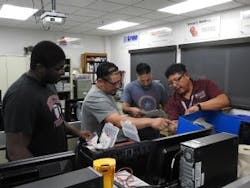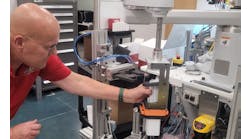Read the full Workforce Week series
Back to school, everybody! Not just the usual students or the hoped-for, next-generation of process engineers and operators. Everybody—including all veterans not yet retiring.
Future professionals are still desperately needed to replace their rapidly retiring counterparts. However, the well-known brain drain is being compounded by technical changes like the Industrial Internet of Things (IIoT), Industry 4.0, cybersecurity and other forms of digitalization, which are evolving and taking over so fast that no one has enough experienced personnel or rookies with the skills to keep up and apply them in their regular operations. Even Amazon reported in July that it plans to spend $700 million to teach 100,000 employees to write software and provide IT support by 2025.
Consequently, where continuing education used to be a nice enrichment option for some process industry staffers, it's quickly becoming an imperative for all technical professionals. Everyone and every organization needs to identify their increasingly widening skills gaps, and learn how to fill them. Time to grow you own with what you've got.
Reinventing professionals
Luckily, many potential operators and technicians—both young and old—are also looking to gain new skills, and get hired by process industry companies with better pay and chances to advance than in their present or former jobs.
"I'm usually a maintenance electrician, mostly troubleshooting motors and other equipment, but my cousin is a plant manager for Ingredion in Bedford Park, Ill., which used to be Corn Products International, and he recently told me to look into process instrumentation and control because it's where some of the greatest need is right now," says David Marcus, 45, who just started the Process Control and Instrumentation Technology (PCIT) associate degree program at Joliet Junior College in Joliet, Ill.
One of Marcus' classmates, Christian Ceja, 21, adds, "My brother completed the PCIT program, and now he's working at Flint Hills Resources in Channahon, Ill., so I thought it would be a good opportunity for me, too."
The PCIT program had been limited to night classes of 12-14 students because its initial instructors had day jobs, mostly at process industry firms in suburban Chicago. However, it just began offering day and night sessions and staggered sections in August, and expects to double attendance to 24 students, according to new, full-time assistant professor/coordinator Joe Limon, who just retired after 41 years at specialty chemical manufacturer Stepan Co., also in Joliet. The two-year associate in applied science (AAS) degree's primary courses include electrical and industrial circuits, digital and computer electronics, industrial and programmable controls, fluid power, process technology, pneumatic and electronic measurement and control, control loop tuning and troubleshooting, analyzers, and industrial data communications. PCIT also offers a four-month certificate of completion (COC) program with five of these core courses. Just as grade school students often learn math concepts before using calculators, both the AAS and COC tracks began by introducing students to traditional pneumatic and relay-based controls before teaching them about programmable and digital controls (Figure 1).
"The PCIT program gets all ages because there are many guys working in warehouses or jobs where the pay isn't great, and they want to better themselves," says Limon. "Having the chance to go from minimum wage to $100K with overtime is a lot better."
Figure 1: Process control students (left to right) Ryan Robinson, Jose Reyes and David Marcus learn how to use a tabletop Wallace Tiernan calibrator for testing pressure gauges from assistant professor/coordinator Joe Limon (right) during their pneumatics section on the second day of their Process Control and Instrumentation (PCIT) class at Joliet Junior College in Joliet, Ill. Source: Jim Montague
Rethinking recruiting
Just as operators and technicians must gain new skills, managers and company leaders must also develop new ways of attracting and hiring the people they require.
"We have a range of different needs and positions, but our approach to recruiting is different than typical system integrators," says Frank Riordan, president of DMC Inc., a system integrator in Chicago, Ill., and certified member of the Control System Integrators Association (CSIA). "We generally hire new college grads. We target smart, hardworking candidates by only recruiting from the best engineering programs at tier-one universities. We also evaluate whether they'll be a good cultural fit.
"We recruited at 26 universities nationwide last year, and we usually interview dozens of candidates on campus and onsite for each one that we hire. We apply these filters to identify quality people. Academic performance is important because you can't have a top GPA and be lazy. We also seek personable individuals. We're not willing to compromise on one or the other; we want both. They have to be independent thinkers that can get things done on their own, but they must also be able to communicate, collaborate and work as part of a team. We strive to hire people that can work across that whole spectrum."
The demanding recruiting and hiring process at DMC requires plenty of time and expense, but Riordan reports it's a worthwhile investment that pays for itself because its new staffers can ramp up faster and are more engaged. The ability to get up to speed quickly is important because DMC gets involved several different industries with many technologies and processes, and is constantly learning new things and applying the latest technologies.
Office environment and locations are also important to DMC’s ability to attract its target workforce. The locations of DMC's offices in hip metro areas are intended to attract recent college grads, who typically flock to urban locations after graduation. DMC also invests in their workspace, providing amenities such as fully stocked kitchens, multiple collaboration areas and even a dog-friendly office policy.
Chris Schleich, engineering manager at Enterprise Automation (EA), a CSIA-certified system integrator in Irvine, Calif., adds that, "Many water/wastewater districts struggle to hire and retain instrument technicians knowledgeable and excited about the trade, though at EA we don't experience that much on the system integration side. When we go to career fairs, the Google, Facebook and Apple booths are mobbed, but that hasn’t limited us from finding kids excited about engineering companies, too," says Schleich. "Computer science has drawn some students away from traditional engineering disciplines built on physics, so they don't learn thermodynamics, heat transfer, fluid mechanics, dynamic forces in motion and statics. These provide a helpful foundation for an engineer to help clients implement industrial processes in the real world. Still, we're not having a problem finding people that want to do what we do, but part of this is we've learned we have to market ourselves with a strong company culture, thorough training and drive towards excellence."
To develop and adopt these principles, Schleich reports Enterprise enrolled its leaders in Vistage executive and business coaching programs. This exposed them to best practices to improve leadership and define the values and mission behind culture. EA also created an internal training program to teach culture and engineering methods to all new hires so they start on the right foot from day one. The training presents the technology skills in a manner that helps automation engineers recognize the gap between information technology (IT) and operations technology (OT) disciplines. He adds that Enterprise also uses Udemy online courses to train staff about SQL, Microsoft servers and other topics not taught in traditional engineering
"We learned that an IT person has a longer journey to be a functional OT person. I've found that someone who started on the OT side is more likely to be able to learn and build a system that supports the IT mission, and gain IT capabilities as needed, instead of the other way around," explains Schleich. "This is important because our engineers build technology solutions, but we must have people that can listen and speak in production terms with the client first to deliver truly excellent solutions."
Because understanding the twin phenomena of brain drain/replacing veterans/encouraging rookies and keeping up with digitalization/IIoT at same time can be overwhelming, it's likely best for individuals to focus on the skill gaps their companies are facing, and use them as a guide to finding the best ways to fill them. To develop an empowered and effective workforce that can take advantage of digitalization and IIoT, Shane Driggers, vice president of global talent acquisition, effectiveness and diversity at Rockwell Automation, reports that managers and organizations must:
- Determine the organizational structure they'll need for more digitalized applications, environments and industries, and realign with that structure;
- Evaluate the organization’s current talent and readiness for change;
- Determine if the right people are in the right jobs and if they have the required skills or have gaps;
- Determine if hiring and/or training can fill those gaps;
- Look for technology enablers that can help migrate toward digitalization;
- Aggressively market open positions and the overall business online and on social media, leveraging strong content in various formats to attract new talent; and
- Show employees that the company is willing to invest in them acquiring new skills, and provide frequent training.
"Twenty years ago, recruiting was still smile-and-dial cold calling and headhunting. What's changed is the social media component, and that marketing available jobs is much more important," explains Driggers. "You must understand your company, its culture and values, and what employees honestly think of it. You'll need a website with videos and content relevant to potential candidates that will engage them long before any phone calls happen. Many people would rather watch a 90-second video that tells how a company wants software developers to solve significant problems. And last, recruiters must become storytellers."
Easing into digitalization
Along with teaching essential control and automation skills, JJC's PCIT program also instills some of the healthy skepticism and less-helpful reluctance that process engineers have about too quickly trusting their applications to intelligent devices that rely on software, microprocessors, networking and/or cybersecurity that might not be sufficient.
"We're delving into smart manufacturing, too, but only for monitoring and maintenance or real-time inventory during custody transfers, but not yet for control," says JJC's Limon. "We're leery about it here, just as we are on the plant-floor because no one wants to get hacked. Process controls previously went from pneumatics and electromechanical relays, and users were leery about PLCs and DCSs until they proved they could safely take over. A similar transition is going on now.
"The biggest advantage of process control and automation is it lets users make quality products consistently. However, there are two kinds of operators: nervous ones that turn valves when they're one point of setpoint, which can cause problems that affect product quality, and laid-back operators that assume their process will come back, which can also cause problems that affect quality. Automation with PLCs and DCSs can help both operators tune their processes better for greater consistency, and smart devices such as self-tuning valves can help even more by adjusting flow rates based on feedback to reach assigned rates. I know we'll adapt to using more smart devices and teaching about them, but it will be based on continuing coordination with local process industry professionals and manufacturers to address their needs that keep changing like everything else."
Transition to teaching
Just as its students update and augment their skills for process applications, PCIT's curriculum was developed with input from control experts at Citgo, Aux Sable, Flint Hills Resources, ExxonMobil, Lyondell Bassell and others, who eventually pitched in to teach classes that would produce new employees for many of them. Filling skill gaps makes teaching—including teaching managers and leaders—another essential skill to learn.
"I started in production and maintenance, and progressed to corporate engineering, but I've almost always gone to school during my career," says Limon. "I earned an associate degree in automated systems for electricians in 1990, and bachelor's degree in electrical engineering with a business minor from Purdue University by going to school part time during 2005-10. Many adults get business degrees, but the EE degree gave me more skills and flexibility when I went back to help manage my company's maintenance and production areas."
Limon reports that Stepan supported him by paying for his education, but later, when eight of its Baby Boomer instrument technicians prepared to retire in 2014, he learned about JJC's PCIT program from the ISA's Will-DuPage chapter, and offered to help teach some of its classes. "Teaching is a different world, and talking to a group can be overwhelming, but it's also similar to managing and mentoring coworkers," explains Limon. "Similar to any community college, we partner with local manufacturers, so what we teach will enable our graduates to step into available jobs, and handle the training they get from their new employers. That's why I'm also a big fan of co-op programs that give students a chance to work onsite because process principles learned in the lab can change in the field.
"But I'm no angel either, and we eventually hired six JJC grads at Stepan. Some later joined bigger fish in our local pond, but we also hired in from other companies, too. Much of this is about professional networking, of course, so our students are also asked to join a LinkedIn group that can help them see what's out there. We also put job opportunities on PCIT's LinkedIn page."
Another PCIT student, Jose Reyes, 38, adds that, "I usually work a body shop, but I knew Joe, and he just recruited me to come in."








